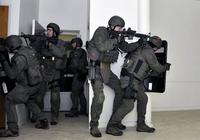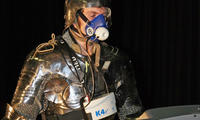-
Bionic bra one step closer
A Bionic Bra which automatically tightens in response to breast movement is one step closer to reality with the development of a new prototype. The development of the bra is the result of findings by researchers that without the right breast support, the movement of women’s breasts during demanding physical activity – in sports, the military, first response, and more – may cause long-term damage, including numbness in the fingers caused by compression of nerves on the shoulders, as well as neck and back pain. “Unfortunately, the most supportive sports bras tend to be the most uncomfortable to wear.” Making matters worse, “research has found that 85 percent of women are wearing bras that do not fit or support their breasts correctly,” one of the researchers said.
-
-
Improved gas mask protects U.S. soldiers against lethal attacks
Choking. Watering eyes. Blistering skin. Convulsions. These are all symptoms of a chemical weapons attack that can lead to imminent death. The lethality of such attacks, most recently the one in Syria in August 2013, can send tremors across the globe. For U.S. Army soldiers, however, chemical weapons present a real danger on the battlefield, and one that requires the most advanced technology to keep them safe. Scientists and researchers at the U.S. Army Edgewood Chemical Biological Center (ECBC) have been working toward better protective equipment, including the iconic gas mask.
-
-
Improving gloves to enhance first responders’ safety
Firefighters wear protective gloves called “structure gloves” to keep their hands safe on the job. The structure gloves currently used by firefighters, however, are not designed for the precision movements first responders must perform. There are many different types of structure gloves available, but none fully satisfies modern firefighters’ needs. Today’s compact tools often have small buttons that require nimble movements. Bulky gloves can make it difficult for firefighters to complete simple tasks without removing their gloves and compromising their safety. As advanced textile technology and materials continue to develop, the science behind firefighter structure gloves has adapted.
-
-
16-year old Seattle girl escapes injury: her glasses deflect bullet
A 16-year old girl escaped potentially life-threatening injury when the glasses she was wearing deflected a bullet fired from a car toward her Seattle home, the Seattle police said. The girl was asleep on her living room couch, with her glasses on, near 10:00 p.m. on Saturday when several shots were fired at the house from a dark-colored sedan. Most of the bullets went through the walls of the house, but one of them went through the front window, striking the bridge of the teen’s glasses. The girl suffered only minor injuries.
-
-
DHS: conspiracy theories about DHS purchases unequivocally false

Conspiracy theorists have pointed to several DHS solicitations for gear and ammunition as “proof” that the department is in the process of creating, training, and equipping a secret force, the purpose of which would be to suppress public dissent – or worse: one blogger wrote that “Another possible conclusion [regarding DHS’s ammo purchases] is that the bullets are intended to coerce and, if need be, kill us.” DHS flatly rejects these conspiratorial assertions as unequivocally false, saying that each and every purchase is in line with past purchases and in support of on-going, legitimate, and transparent departmental operations.
-
-
Researchers fabricate new camouflage coating from squid protein

What can the U.S. military learn from a common squid? A lot about how to hide from enemies, according to researchers. Researchers show that material that mimics calamari skin is invisible to infrared cameras, which is a good thing since infrared detection equipment is employed extensively by military forces for night vision, navigation, surveillance, and targeting.
-
-
Nanostructured material stronger than a speeding bullet
Providing protection against impacts from bullets and other high-speed projectiles is more than just a matter of brute strength; while traditional shields have been made of bulky materials such as steel, newer body armor made of lightweight material such as Kevlar has shown that thickness and weight are not necessary for absorbing the energy of impacts; new tests of nanostructured material could lead to better armor against everything from gunfire to micrometeorites
-
-
New military apparel repels chemical, biological agents
Scientists are developing a new military uniform material that repels chemical and biological agents using a novel carbon nanotube fabric; the material will be designed to undergo a rapid transition from a breathable state to a protective state; the highly breathable membranes would have pores made of a few-nanometer-wide vertically aligned carbon nanotubes that are surface modified with a chemical warfare agent-responsive functional layer
-
-
Mantis shrimp could inspire new body, vehicle armor

The unique and highly complex structure of fist-like club of mantis shrimp could transform materials used to create military body armor and vehicle and aircraft frames
-
-
Air-conditioned protective clothing for police, first responders, soldiers
Bullet-proof vests made of Kevlar; the material holds off bullets, but it also impenetrable to water vapor; police personnel who must wear such gear under their uniforms sweat profusely when the weather is warm; researchers develop a “smart,” air-conditioned protective vest, and the smart cooling technology is also suitable for protective suits worn over normal clothing, uniform jackets, camouflage suits
-
-
DHS to equip border agents with new body armor
The Customs and Border Protection buys $48,629,750 worth of personal body armor from North Carolina-based KDH Defense systems
-
-
E-textiles now come with memory-storing fiber
E-textiles could help soldiers, first responders — but also the sick and infirm; the integration of electronics into textiles is a growing field of research that may soon enable smart fabrics and wearable electronics
-
-
Why the Twin Towers collapsed: new theory
Materials scientist says that a mixture of water from sprinkler systems and molten aluminum from melted aircraft hulls created explosions that led to the collapse of the Twin Towers on 9/11
-
-
New vest offers GPS tacking and other information
Canadian company Laipac Technology is showing its S911 GPS Vest which the company describes as “a high coverage assault protection designed for military, tactical law enforcement and VIP personnel that demand the highest protection.”
-
-
Too much armor hampered French

The French may have had a better chance at the Battle of Agincourt had they not been weighed down by heavy body armor; during warfare in the fifteenth century, soldiers wore steel plate armor, typically weighing 30-50 kg; this may have been a contributing factor in whether an army won or lost a battle
-
- All
- Regional
- Water
- Biometrics
- Borders/Immig
- Business
- Cybersecurity
- Detection
- Disasters
- Government
- Infrastructure
- International
- Public health
- Public Safety
- Communication interoperabillity
- Emergency services
- Emergency medical services
- Fire
- First response
- IEDs
- Law Enforcement
- Law Enforcement Technology
- Military technology
- Nonlethal weapons
- Nuclear weapons
- Personal protection equipment
- Police
- Notification /alert systems
- Situational awareness
- Weapons systems
- Sci-Tech
- Sector Reports
- Surveillance
- Transportation
Advertising & Marketing: advertise@newswirepubs.com
Editorial: editor@newswirepubs.com
General: info@newswirepubs.com
2010-2011 © News Wire Publications, LLC News Wire Publications, LLC
220 Old Country Road | Suite 200 | Mineola | New York | 11501
Permissions and Policies
Editorial: editor@newswirepubs.com
General: info@newswirepubs.com
2010-2011 © News Wire Publications, LLC News Wire Publications, LLC
220 Old Country Road | Suite 200 | Mineola | New York | 11501
Permissions and Policies
